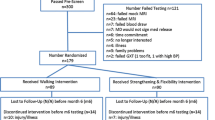Abstract
To assess the effect of an exercise intervention using a weighted vest on perceived health status and bone density in older persons, we enrolled 36 seniors in a randomized controlled trial. The vest-use group met weekly for 1 h for a low level exercise class. They wore a weighted vest during the class and as tolerated at home. The discussion controls met for 1 h weekly. At baseline and follow-up (20 weeks), subjects completed a questionnaire that incuded the 20 item MOS Short-Form Health Survey, Multidimensional Health Locus of Control Scale, and Philadelphia Geriatric Center Morale Scale, and bone density was measured by dual energy X-ray absorptiometry. Subjects also completed daily activity diaries. Subjects in the vest group reported a statistically significant dicrease in bodily pain, improved physical functioning, and increased internal health locus of control. Bone density increased by 1% in the vest group and decreased by 0.6% in the controls (p=0.12). We conclude that our exercise intervention had a positive effect on some measures of perceived health in older persons.
Similar content being viewed by others
References
Fries JF. The compression of morbidity. Milbank Mem Fund Q 1983; 61: 397–419.
Fries JF, Green LW, Levine S. Health promotion and the compression of morbidity. Lancet 1989; i: 418–483.
Cummings SR, Black DM, Rubin SM. Lifetime risk of hip, colles, or vertebral fracture and coronary heart disease among white postmenopausal women. Arch Intern Med 1989; 148: 2445–2448.
Marcus R, Carter D. Exercise and the regulation of bone mass. Arch Intern Med 1989; 149: 2170–2171.
Blumenthal JA, Emery CF, Madden DJ, et al. Cardiovascular and behavioral effects of aerobic exercise training in men and women. J Gerontol Med Sci 1989; 44: 147–157.
Emery CF, Blumenthal JA. Perceived change among participants in an exercise program for older adults. Gerontologist 1990; 30: 516–521.
Parfitt AM. The cellular basis of bone remodelling: the quantum concept reexamined in light of recent advances in the cell biology of bone. Calcif Tiss Int 1984; 36: S37-S45.
Raisz LG. Local and systemic factors in the pathogenesis of osteoporosis. N Engl J Med 1988; 318: 818–827.
Hayes WC, Gerhart TN. Biomechanics of bone: Applications for assessment of bone strength. In: Peck WA, ed. Bone and Mineral Research 3rd edn. B.V., New York: Elsevier Science Publishers, 1985: 259–294.
Whalen RT, Carter DR, Steele CR. Influence of physical activity on the regulation of bone density. J Biomechanics 1988; 21: 825–837.
Fiatarone MA, Marks EC, Ryan ND, et al. High intensity strength training in nonagenarians. JAMA 1990; 263: 3029–3034.
American College of Sports Medicine. Guidelines for Exercise Testing and Prescription. Philadelphia: Lea & Febiger, 1991.
Shephard RJ. Physical Activity and Aging. London: Croom Helm, 1987.
Ware JE, Sherbourne CD, Davies AR. Developing and testing the MOS 20-item short-form health survey: a general population application. In: Stewart AL and Ware JE, eds. Measuring Functioning and Well-Being: The Medical Outcomes Study Approach. Durham, NC: Duke University Press: 1992: 277–290.
Stewart AL, Hays RD, Ware JE. The MOS Short-Form General Health Survey: Reliability and validity in a patient population. Med Care 1988; 26: 724–735.
Stewart AL, Greenfield S, Hays RD, et al. Functional status and well being in patients with chronic conditions. JAMA 1989; 262: 907–913.
Wallston BS, DeVellis R. Development of the multidimensional health locus of control scale. Health Education Monographs. Health Educ Q 1978; 6: 160–170.
Lawton MP. The Philadelphia Geriatric Morale Scale: a revision. J Gerontol 1975; 30: 85–89.
Csuka M, McCarthy DJ. Simple method for measurement of lower extremity muscle strength. Am J Med 1985; 78: 77–81.
Cronbach L. Coefficient alpha and the internal structure of tests. Psychometrika 1959; 16: 297–334.
Colton T. Statistics in Medicine. Boston: Little Brown & Co. Inc., 1974.
Mickey R, Greenland S. The impact of confounder selection criteria on effect estimation. Am J Epidemiol 1989; 129: 125–137.
Nunnally JC. Psychometric Theory, 2nd edn. New York: McGraw-Hill; 1978.
Wallston KA, Wallston BS. Health locus of control scales. In: Lefcourt J, ed. Advances and Innovations in Locus of Control Research. New York: Academic Press, 1981: 189–243.
Hale WD, Cochran CD. Locus of control across the adult life span. Psychol Rep 1986; 59: 311–313.
Lumpkin JR. The relationship between locus of control and age: new evidence. J Soc Behav Pers 1986; 1: 245–252.
Knoop R. Locus of control: a work-related variable? J Soc Psychol 1989; 129: 101–106.
Aasen N. Interventions to facilitate personal control. J Gerontol Nurs 1987; 13: 20–28.
Tulloch AJ, Moore V. A randomized controlled trial of geriatric screening in general practice. J R Coll Gen Pract 1979; 29: 733–739.
Levkoff SE, Cleary PD, Wetle T, Besdene RW. Illness behavior in the aged. J Am Geriatr Soc 1988; 36: 622–629.
Rubenstein LV, Calkins DR, Greenfield S, et al. Health status assessment for elderly patients. J Am Geriatr Soc 1988; 37: 562–569.
Stewart AL, Kings AC, Preston S, et al. Functioning and well-being associated with older adults' participation in exercise. Gerontologist 1991; II: 9.
Lindsay R. Estrogen therapy in the prevention and management of osteoporosis. Am J Obstet Gynecol 1987; 156: 1347–1351.
Chow R, Harrison J, Notarius C. Effect of two randomized programmes on bone mass in health postmenopausal women. Br Med J 1987; 295: 1441–1444.
Haskell, WL, Leon, AS, Casperson, CL, et al. Cardiovascular benefits and assessment of physical fitness in adults. Med Sci Sports Exercise 1992; 24: S201.
Incidence of injury during moderate and high-intensity walking training in the elderly. J Gerontol Med Sci 1992; 47: M61–66.
Author information
Authors and Affiliations
Additional information
This work was supported by grants from the Charles A. Dana Foundation, the UCLA Academic Senate, and the Bureau of Health Professions Mid-Career Faculty Training Grant.
Rights and permissions
About this article
Cite this article
Greendale, G.A., Hirsch, S.H. & Hahn, T.J. The effect of a weighted vest on perceived health status and bone density in older persons. Qual Life Res 2, 141–152 (1993). https://doi.org/10.1007/BF00435733
Received:
Accepted:
Issue Date:
DOI: https://doi.org/10.1007/BF00435733




